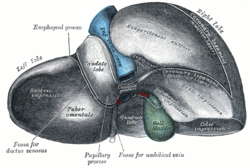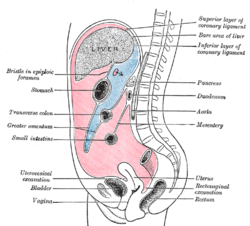- Coronary ligament
-
For the coronary ligament of the knee, see Coronary ligament of the knee.
Coronary ligament 
Posterior and inferior surfaces of the liver. (Coronary ligament labeled at center right.) 
Vertical disposition of the peritoneum. Main cavity, red; omental bursa, blue. Latin ligamentum coronarium hepatis Gray's subject #250 1192 The coronary ligament of the liver refers to parts of the peritoneal reflections that hold the liver to the inferior surface of the diaphragm.
Contents
Structure
The convex diaphragmatic surface of the liver (anterior, superior and a little posterior) is connected to the concavity of the inferior surface of the diaphragm by reflections of peritoneum. The coronary ligament is the largest of these, having an anterior (frontal) and posterior (back) layers.
The diaphragmatic surface of the liver that is in direct contact with the diaphragm (just beyond the peritoneal reflections) has no peritoneal covering, and is termed the bare area of the liver.
The anterior layer of the coronary ligament is formed by the reflection of the peritoneum from the upper margin of the bare area of the liver to the under surface of the diaphragm.
The posterior layer of the coronary ligament is reflected from the lower margin of the bare area and is continuous with the right layer of the lesser omentum.
The anterior and posterior layers converge on the right and left sides of the liver to form the right triangular ligament and the left triangular ligament, respectively. In between the two sides of the anterior layer, the reflection of peritoneum has an inferior continuation termed the falciform ligament. The falciform ligament contains the round ligament of liver.
Additional images
References
- Gray, Henry (1918). Anatomy of the Human Body. Philadelphia: Lea & Febiger. Bartleby.com, 2000. 2i. The Liver.
- Moore, Keith L.; Dalley, Arthur F. (2006). Clinically Oriented Anatomy (5th ed.). Philadelphia: Lippincott Williams & Wilkins. ISBN 0-7817-3639-0.
External links
- liver at The Anatomy Lesson by Wesley Norman (Georgetown University) (liveranterior, liversuperior)
This article was originally based on an entry from a public domain edition of Gray's Anatomy. As such, some of the information contained within it may be outdated.
Categories:- Ligaments
- Liver anatomy
- Ligament stubs
Wikimedia Foundation. 2010.

